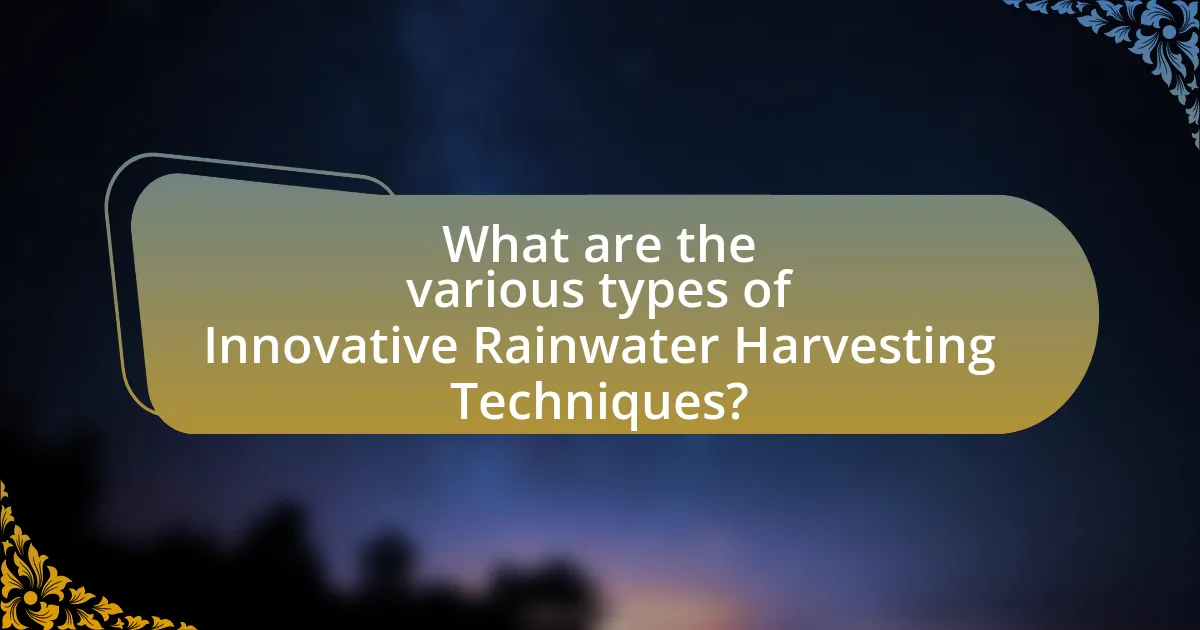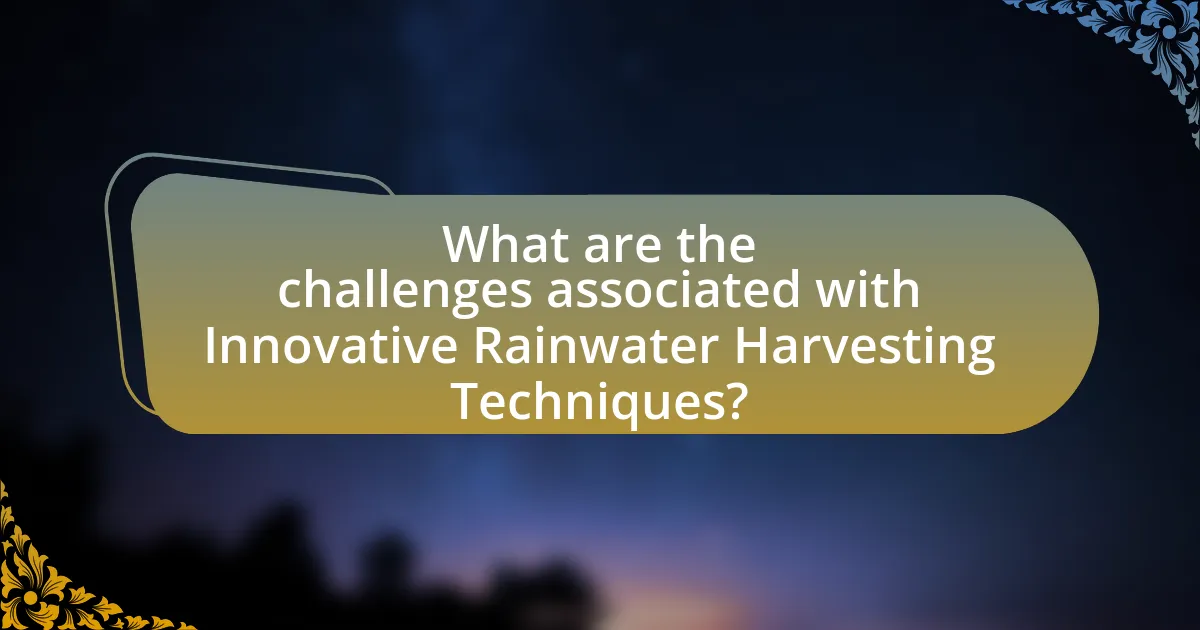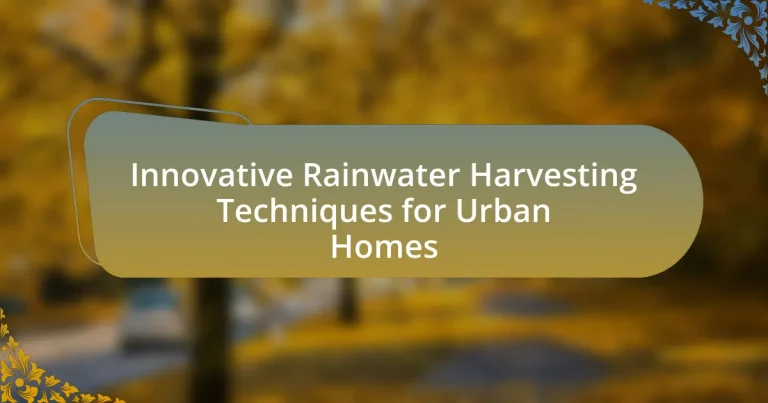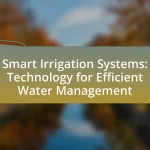Innovative rainwater harvesting techniques for urban homes encompass methods such as green roofs, rain gardens, and modular storage systems, which enhance water conservation and stormwater management. These modern approaches differ from traditional methods by integrating advanced technology, improving efficiency and adaptability. Key features include sustainability, effective filtration, and customization for various urban environments. The article outlines the benefits of these techniques, including reduced water bills and improved urban biodiversity, while also addressing challenges such as regulatory hurdles and maintenance requirements. Practical tips for homeowners on assessing their properties and accessing resources for implementation are also provided.

What are Innovative Rainwater Harvesting Techniques for Urban Homes?
Innovative rainwater harvesting techniques for urban homes include green roofs, rain gardens, and modular rainwater storage systems. Green roofs utilize vegetation to absorb rainwater, reducing runoff and promoting evaporation, while rain gardens are designed to capture and filter rainwater, enhancing groundwater recharge. Modular rainwater storage systems consist of interlocking units that can be installed underground to collect and store rainwater efficiently, allowing for easy access and use for irrigation or non-potable applications. These techniques not only conserve water but also mitigate urban flooding and improve stormwater management.
How do these techniques differ from traditional methods?
Innovative rainwater harvesting techniques differ from traditional methods primarily in their efficiency and integration with modern technology. Traditional methods often rely on simple collection systems, such as barrels or cisterns, which may not optimize water capture or storage. In contrast, innovative techniques utilize advanced filtration systems, smart sensors, and automated controls to enhance water quality and management. For example, systems that incorporate IoT technology can monitor rainfall patterns and adjust collection strategies in real-time, significantly improving water conservation efforts. This technological integration leads to a more sustainable and effective approach to rainwater harvesting, as evidenced by studies showing that modern systems can increase water capture rates by up to 50% compared to traditional methods.
What are the key features of innovative techniques?
The key features of innovative techniques in rainwater harvesting for urban homes include efficiency, sustainability, and adaptability. Efficiency is demonstrated through advanced filtration systems that maximize water quality and minimize waste, allowing for effective collection and use of rainwater. Sustainability is achieved by utilizing eco-friendly materials and methods that reduce environmental impact, such as permeable surfaces that enhance groundwater recharge. Adaptability refers to the ability of these techniques to be customized for various urban settings, accommodating different building designs and local climate conditions. These features collectively enhance the effectiveness of rainwater harvesting systems, making them viable solutions for urban water management.
Why is innovation important in rainwater harvesting?
Innovation is important in rainwater harvesting because it enhances efficiency, sustainability, and adaptability to urban environments. Advanced technologies, such as smart sensors and automated systems, optimize water collection and usage, significantly increasing the effectiveness of rainwater harvesting systems. For instance, a study by the International Water Association highlights that innovative filtration and storage solutions can improve water quality and reduce maintenance costs by up to 30%. Additionally, innovative designs can integrate seamlessly into urban infrastructure, making rainwater harvesting more accessible and practical for homeowners.
What are the benefits of implementing these techniques in urban settings?
Implementing innovative rainwater harvesting techniques in urban settings provides significant benefits, including reduced water consumption and enhanced stormwater management. These techniques allow urban homes to capture and utilize rainwater, decreasing reliance on municipal water supplies and lowering water bills. Additionally, effective rainwater harvesting mitigates flooding and reduces the burden on drainage systems during heavy rainfall, as evidenced by studies showing that cities with rainwater harvesting systems experience less urban runoff and improved water quality. Furthermore, these systems contribute to sustainable urban development by promoting water conservation and resilience against climate change impacts.
How do these techniques contribute to sustainability?
Innovative rainwater harvesting techniques contribute to sustainability by efficiently capturing and utilizing rainwater, thereby reducing reliance on municipal water supplies. These techniques help mitigate urban flooding, decrease stormwater runoff, and promote groundwater recharge. For instance, systems that collect rainwater for irrigation can significantly lower water consumption, with studies indicating that rainwater harvesting can reduce potable water use by up to 50% in urban settings. Additionally, the implementation of such systems can lead to lower energy consumption associated with water treatment and distribution, further enhancing environmental sustainability.
What cost savings can homeowners expect?
Homeowners can expect significant cost savings through innovative rainwater harvesting techniques, potentially reducing water bills by up to 50%. By collecting and utilizing rainwater for irrigation, toilet flushing, and other non-potable uses, homeowners decrease their reliance on municipal water supply. A study by the American Rainwater Catchment Systems Association indicates that a properly designed rainwater harvesting system can save an average household approximately $1,000 annually on water costs. Additionally, these systems can lower stormwater management fees and reduce the need for expensive landscaping, further contributing to overall savings.

What are the various types of Innovative Rainwater Harvesting Techniques?
Innovative rainwater harvesting techniques include rooftop rainwater harvesting, permeable pavements, rain gardens, and underground storage systems. Rooftop rainwater harvesting captures rainwater from building roofs, directing it into storage tanks for later use, which can reduce reliance on municipal water supplies. Permeable pavements allow rainwater to infiltrate through surfaces, reducing runoff and promoting groundwater recharge. Rain gardens are designed to collect and absorb rainwater, utilizing native plants to filter pollutants and enhance biodiversity. Underground storage systems involve the collection of rainwater in subsurface tanks, optimizing space in urban environments while providing a sustainable water source. These techniques are supported by studies indicating their effectiveness in managing stormwater and conserving water resources in urban settings.
How does a rain garden function in urban homes?
A rain garden functions in urban homes by capturing and filtering stormwater runoff, thereby reducing flooding and improving water quality. This garden is designed with native plants and soil that absorb excess rainwater, allowing it to infiltrate the ground rather than overwhelming drainage systems. Research indicates that rain gardens can reduce runoff by up to 90%, effectively managing stormwater and promoting groundwater recharge. Additionally, they provide habitat for wildlife and enhance the aesthetic value of urban landscapes.
What plants are best suited for rain gardens?
Plants best suited for rain gardens include native species such as Joe Pye weed, black-eyed Susan, and cardinal flower. These plants thrive in wet conditions and are adapted to local climates, making them effective for managing stormwater runoff. Research indicates that native plants enhance biodiversity, support local wildlife, and require less maintenance compared to non-native species, thus proving their suitability for rain gardens.
How do rain gardens improve urban biodiversity?
Rain gardens improve urban biodiversity by creating habitats that support a variety of plant and animal species. These gardens utilize native plants that attract pollinators, such as bees and butterflies, and provide food and shelter for birds and small mammals. Research indicates that rain gardens can increase local species richness by up to 30%, as they mimic natural ecosystems and enhance soil health through improved water infiltration and reduced runoff. This ecological function not only fosters diverse biological communities but also contributes to the overall resilience of urban environments against climate change impacts.
What role do green roofs play in rainwater harvesting?
Green roofs play a significant role in rainwater harvesting by capturing and retaining rainwater, which reduces runoff and promotes water reuse. These systems utilize vegetation and soil layers to absorb rainfall, allowing for gradual release into drainage systems or for direct use in irrigation. Studies indicate that green roofs can retain up to 80% of annual rainfall, effectively mitigating urban flooding and decreasing the demand on stormwater infrastructure. This retention capacity not only enhances urban water management but also contributes to improved biodiversity and air quality in urban environments.
How can green roofs be designed for maximum efficiency?
Green roofs can be designed for maximum efficiency by incorporating a multi-layer system that includes a waterproof membrane, drainage layer, growing medium, and vegetation. This layered approach ensures effective water management, promotes plant health, and enhances thermal insulation. Research indicates that green roofs can reduce stormwater runoff by up to 75%, as they absorb and retain rainwater, which is crucial for urban environments facing flooding challenges. Additionally, selecting native and drought-resistant plant species can minimize irrigation needs, further increasing the roof’s efficiency and sustainability.
What maintenance is required for green roofs?
Green roofs require regular maintenance to ensure their health and functionality. This maintenance includes tasks such as inspecting the vegetation for pests and diseases, ensuring proper drainage, and replacing dead plants. Additionally, periodic weeding is necessary to prevent invasive species from taking over. According to the Green Roofs for Healthy Cities organization, maintaining a green roof can enhance its lifespan and performance, with recommended inspections occurring at least twice a year. Regular maintenance not only supports plant health but also optimizes the roof’s ability to manage rainwater effectively.

What are the challenges associated with Innovative Rainwater Harvesting Techniques?
Innovative rainwater harvesting techniques face several challenges, including high initial costs, regulatory hurdles, and maintenance requirements. The installation of advanced systems often requires significant financial investment, which can deter homeowners from adopting these technologies. Additionally, local regulations may impose restrictions on rainwater collection, complicating implementation. Maintenance is another critical challenge, as systems must be regularly cleaned and inspected to ensure efficiency and prevent contamination. These factors collectively hinder the widespread adoption of innovative rainwater harvesting solutions in urban settings.
What regulatory hurdles might homeowners face?
Homeowners may face regulatory hurdles such as local zoning laws, building codes, and permits when implementing rainwater harvesting systems. These regulations often dictate the design, installation, and maintenance of such systems to ensure safety and environmental compliance. For instance, some municipalities require specific permits for rainwater collection systems, while others may have restrictions on the types of materials used or the size of the storage tanks. Additionally, homeowners must navigate state regulations that can vary significantly, impacting the feasibility and legality of their rainwater harvesting projects.
How can homeowners navigate local regulations?
Homeowners can navigate local regulations by researching their municipality’s specific codes and guidelines related to rainwater harvesting. This involves visiting local government websites, consulting with planning departments, and reviewing zoning laws that pertain to water collection systems. For instance, many cities have established regulations that dictate the size, design, and maintenance of rainwater harvesting systems to ensure safety and compliance with health standards. Engaging with local environmental agencies can also provide insights into any incentives or requirements for sustainable practices.
What permits are typically required for installation?
Typically, installation of rainwater harvesting systems requires permits such as building permits, plumbing permits, and sometimes environmental permits. Building permits ensure compliance with local construction codes, while plumbing permits are necessary for any modifications to existing plumbing systems. Environmental permits may be required to ensure that the system does not negatively impact local water resources or ecosystems. Local regulations vary, so it is essential to consult with municipal authorities to determine the specific permits needed for a rainwater harvesting installation.
What common misconceptions exist about rainwater harvesting?
Common misconceptions about rainwater harvesting include the belief that it is illegal, that it is unsafe to drink, and that it requires extensive maintenance. Many people think rainwater harvesting is prohibited, but in fact, most regions allow it with specific regulations to ensure safety. Additionally, while untreated rainwater may contain contaminants, proper filtration and treatment systems can make it safe for consumption. Lastly, the misconception that rainwater systems require high maintenance is misleading; modern systems are designed to be low-maintenance, often needing only occasional cleaning and inspection.
How can these misconceptions be addressed?
Misconceptions about innovative rainwater harvesting techniques for urban homes can be addressed through education and awareness campaigns. These initiatives should focus on providing accurate information about the benefits, feasibility, and maintenance of rainwater harvesting systems. For instance, studies show that rainwater harvesting can reduce water bills by up to 50% and alleviate pressure on municipal water supplies, which counters the misconception that these systems are ineffective or too costly to implement. Additionally, workshops and community demonstrations can help dispel myths by showcasing successful installations and their ease of use, thereby fostering greater acceptance and understanding among urban homeowners.
What are the real risks of rainwater harvesting?
The real risks of rainwater harvesting include contamination of the water supply, structural damage to collection systems, and potential legal or regulatory issues. Contamination can occur from pollutants on rooftops, such as bird droppings or chemicals, which can compromise water quality. Structural damage may arise from improper installation or maintenance of storage tanks, leading to leaks or failures. Additionally, some regions have regulations that restrict or prohibit rainwater harvesting, posing legal risks for homeowners. These risks highlight the importance of proper system design, maintenance, and adherence to local laws to ensure safe and effective rainwater harvesting.
What practical tips can homeowners follow to implement these techniques effectively?
Homeowners can effectively implement innovative rainwater harvesting techniques by first assessing their property to identify suitable locations for rainwater collection systems, such as rooftops and gutters. Installing a properly sized rain barrel or cistern can capture and store rainwater, which should be connected to downspouts for efficient collection. Regular maintenance, including cleaning gutters and checking for leaks, ensures optimal performance. Additionally, homeowners should consider using filtration systems to purify collected rainwater for non-potable uses, such as irrigation or toilet flushing. According to the American Rainwater Catchment Systems Association, properly designed systems can reduce water bills by up to 50%, demonstrating the effectiveness of these techniques.
How can homeowners assess their property for rainwater harvesting potential?
Homeowners can assess their property for rainwater harvesting potential by evaluating the roof size, slope, and material, as well as the local rainfall patterns and drainage systems. A larger roof area with a steep slope made of non-porous materials, such as metal or tiles, can effectively collect more rainwater. Additionally, homeowners should analyze their region’s average annual rainfall, which can be found in local meteorological data, to estimate the volume of water that can be harvested. Proper assessment also involves checking existing gutters and downspouts for efficiency and ensuring that the property has adequate space for storage tanks.
What resources are available for homeowners looking to start?
Homeowners looking to start with rainwater harvesting can access several resources, including local government programs, online guides, and community workshops. Local government programs often provide incentives, such as rebates or grants, to encourage rainwater harvesting, which can be verified through municipal websites. Online guides, such as those from the Environmental Protection Agency, offer detailed instructions on system design and installation. Community workshops frequently organized by environmental organizations provide hands-on training and expert advice, enhancing practical knowledge for homeowners. These resources collectively support homeowners in effectively implementing rainwater harvesting techniques.


